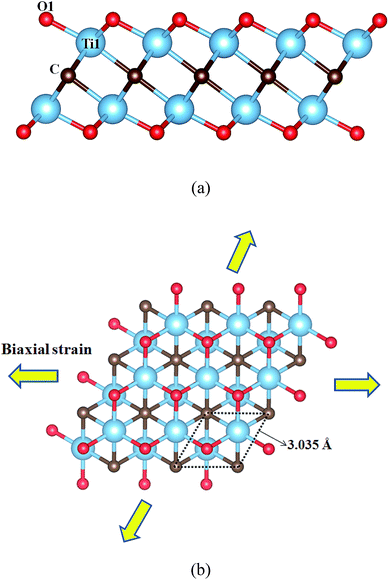The band gap modulation of monolayer Ti2CO2 by strain
Xue-fang Yu,
Jian-bo Cheng,
Zhen-bo Liu,
Qing-zhong Li,
Wen-zuo Li,
Xin Yang and
Bo Xiao*
The Laboratory of Theoretical and Computational Chemistry, School of Chemistry and Chemical Engineering, Yantai University, Yantai 264005, People's Republic of China. E-mail: xiaoboy8@gmail.com
First published on 23rd March 2015
Abstract
Ti2C is the thinnest member in the MXene family with great potential for applications. In the present study, we have investigated the band gap modulation of O-terminated Ti2C (Ti2CO2) monolayer under biaxial or uniaxial strain through first-principles simulation. Our results reveal that monolayer Ti2CO2 could undergo an indirect to direct band gap transition under the biaxial strain of ∼4%, and the uniaxial strain of ∼6%. Similarly, the band gap modulation also occurs in monolayer Zr2CO2 and Hf2CO2 when 10% and 14% biaxial strains are applied, respectively. The detailed reasons for the band gap modulation are also discussed. Our studies have crucial implications for the application of monolayer MXene in opto-electronics and optical devices.
1. Introduction
It is well established that MAX (Mn+1AXn) phases are a large family of ternary layered carbides and nitrides, where M is an early transition metal, n = 1–3, A usually belongs to the groups IIIA and IVA, and X is carbon or nitrogen.1 Generally, they are considered as layers of A intercalated into the Mn+1Xn building block. Very recently, it has been reported that element A can be selectively etched away using HF acid, and the remaining 2D layered structure after exfoliation is termed as MXene.2Because of the structural similarity between MXene and graphene, MXene has a wide potential for applications. Since Gogotsi et al. revealed the potential use of MXene layers (Ti3C2) for electrochemical energy storage, such as electrodes for batteries, supercapacitors, and hybrid devices,3 several theoretical and experimental studies have extensively reported the performance of MXene as an anode material for metal ion batteries, spintronic and the optical devices.4–7 In addition, 2D MXene phases have a variety of electronic and magnetic properties differing from their parent MAX phases, and these can be used to tune the band gap of the semiconductors, e.g., MoS2.8
Ti2C is one of the thinnest MXene phases, found to be terminated with several kinds of functional group, such as F, OH and/or O in the real etching process with HF acid.2 It has already been revealed that the electronic property of Ti2C is strongly dependent on the functional group, with Ti2CO2 exhibiting semiconductor character, Ti2CF2 and Ti2C(OH)2 exhibiting metallic character.9
As a semiconductor, previous study shows that Ti2CO2 has an indirect band gap, calculated to be about 0.24 eV and 0.88 eV with the PBE and HSE06 functionals, respectively.10 Although it has a moderate band gap, it is not wise to use it in the optical devices since it has an indirect band gap, which interrupts efficient light emission. Previous studies revealed that the indirect to direct band gap transition of 2D materials may occur under the external strain or external field.7,11,12 Stimulated by this idea, in this work, we studied the band gap modulation with external strain to explore more potential utilization of monolayer Ti2CO2 through first-principles simulation. By increasing the biaxial strain to 4%, the smaller indirect band gap switch to a larger direct band gap. The transition of the indirect band gap to direct also occurs with uniaxial strain, but at least 6% strain should be applied. The reason of the band gap transition from indirect to direct is also discussed. In addition, the band gap modulation (from indirect to direct) has also been confirmed in monolayer Zr2CO2 and Hf2CO2 with the applied biaxial strains 10% and 14%, respectively.
2. Computational method
The density functional theory (DFT) calculation was performed using the Vienna Ab initio Simulation Package.13,14 The electron–ion interaction was described by projector augmented-wave (PAW)15 pseudopotentials. For the exchange and correlation functionals, we use the Perdew–Burke–Ernzerhof (PBE) version of the generalized gradient approximation (GGA).16 The same method has been applied in the band gap transition in monolayer Sc2CO2 under strains7 or electric fields.17 The energy cutoff of 520 eV was used for the wave functions expansion. K-point of 12 × 12 × 1 grid was used for Brillouin-zone integrations. The geometries were fully optimized until the forces on each atom is less than 0.01 eV Å−1. Gaussian smearing of 0.1 was used for DOS calculation with 24 × 24 × 1 grid. The periodic structure of Ti2CO2 monolayer has been decoupled by a vacuum thickness larger than 20 Å.3. Results and discussion
Model 2 in previous study9 is conformed to be the most stable structure of O functionalized monolayer Ti2C shown in Fig. 1. The lattice parameter of Ti2CO2 unit cell is 3.035 Å, which is consistent with other theoretical studies.9,10 The schematic illustration of the biaxial strains is shown in Fig. 1b. Here, the strain is defined as ε = (a − a0)/a0, where a0 and a are the lattice parameter of the unit cell without strain and strain, respectively. To study the change of the band gap by the strain effect, we applied both biaxial and uniaxial strain from 0% to 7% with reference to the optimized lattice parameter of the most stable model. The band structures of the monolayer Ti2CO2 under each strain were examined shown in Fig. 2. It should be noted that the structures of monolayer Ti2CO2 almost remain intact under the strains employed (from 0% to 7%), and the corresponding band gap changes are not particularly dramatic. We found that, under the strain-free state, monolayer Ti2CO2 has a Γ (valence band maximum, VBM) to M (conduction band minimum, CBM) indirect band gap of about 0.29 eV, which agrees well with previous studies.10 Under biaxial strain (Fig. 2a), the CBM at the M point is raised in energy level with respect to the strain-free case, and finally leading to a Γ to Γ direct band gap (0.53 eV) when 4% (or even larger) biaxial strain is applied to this system. Similar behavior occurs when uniaxial strain is applied to the monolayer Ti2CO2 system, and the indirect to direct band gap modulation could be realized under at least 6% uniaxial strain as shown in Fig. 2b. We note that, in the monolayer Ti2CO2, the VBM position shows weak dependence on both the biaxial and the uniaxial strain, while the CBM strongly depends on the strain. Thus, the change of the energy level at CBM state mainly contribute to the indirect to direct band gap transition in Ti2CO2 system, which is quite different from that in monolayer Sc2CO2, where the indirect to direct band gap transition from the variation of the energy levels at VBM state.7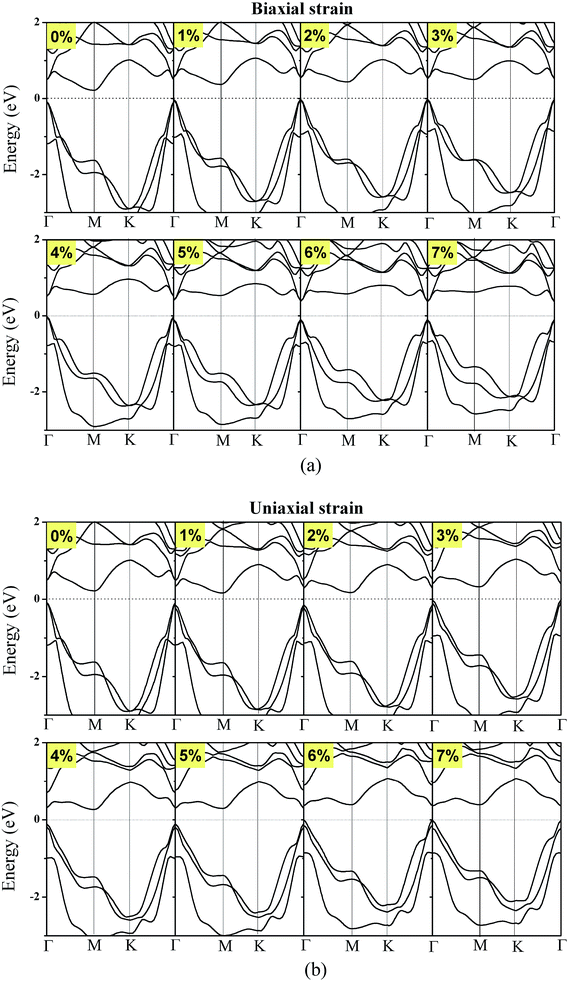 | ||
| Fig. 2 The band structures of monolayer Ti2CO2 under various (a) biaxial and (b) uniaxial strains from 0% to 7%. | ||
Fig. 3 plots the changes of ΓVBM to Γ and ΓVBM to M band gaps of monolayer Ti2CO2 as a function of biaxial or uniaxial strains. It is found that, under both biaxial and uniaxial strain cases, the values of ΓVBM to Γ band gap decrease with the increment of the strain, while the values of ΓVBM to M band gap increase with increment of the strain. Thus, the band gap of the monolayer Ti2CO2 increases first, and reaches the max point (indirect to direct band gap transition), followed by a decrease as the strain increases. Similar band gap changes also could be found in monolayer ZrS2 under tensile strain.12
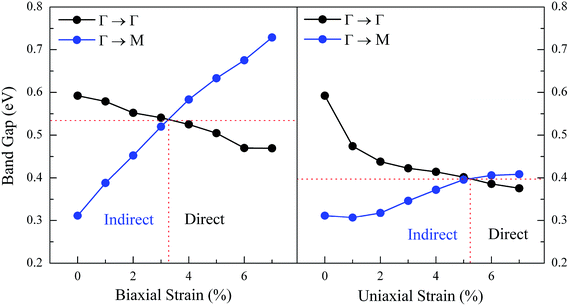 | ||
| Fig. 3 The ΓVBM to Γ and ΓVBM to M band gap values dependent on the various biaxial and uniaxial strains from 0% to 7%. | ||
To understand the origin of the band gap modulation, the contribution of each atom to the band structure has been considered as shown in Fig. 4. Under the strain-free case (Fig. 4a), the energy level at the VBM is mainly contributed from 2Ti, C and 2O atoms with the factors 25%, 43% and 32%, respectively. While 2Ti and 2O atoms mainly contribute to the energy level at the CBM with 74% and 26%, respectively. Under 7% biaxial (or uniaxial) strain case as shown in Fig. 4b (or Fig. 4c), the energy level at VBM still originates from 2Ti, C and 2O atoms with the factors 24% (38%), 43% (37%) and 33% (25%), respectively. While the contribution of energy level at CBM changes from the combination of 2Ti and O atoms into only 2Ti atoms according to the CBM transition from the M to Γ point. In detail, the partial density of states (PDOS) of each component in monolayer Ti2CO2 under strain-free and 7% biaxial strain cases have been considered as comparison in Fig. 5. It is found that the CBM (energy level at M point) of strain-free Ti2CO2 is mainly contributed from the dz2 orbital of Ti atom and the py orbital of the O atom. It should be noted that the y orbital is more sensitive to the in-plane strain than the z orbital. Therefore, under the 7% biaxial strain case, the py orbital of O atom moves upward obviously with respect to the Fermi level as shown in Fig. 5b, and the CBM (energy level at Γ point) is only influenced by the Ti atom, where the contributions of dz2, dxz and dx2−y2 orbitals are predominant. Thus, the indirect to direct band gap modulation of the monolayer Ti2CO2 under tensile strains mainly results from the disappearance of py orbital of the O atom at CBM state.
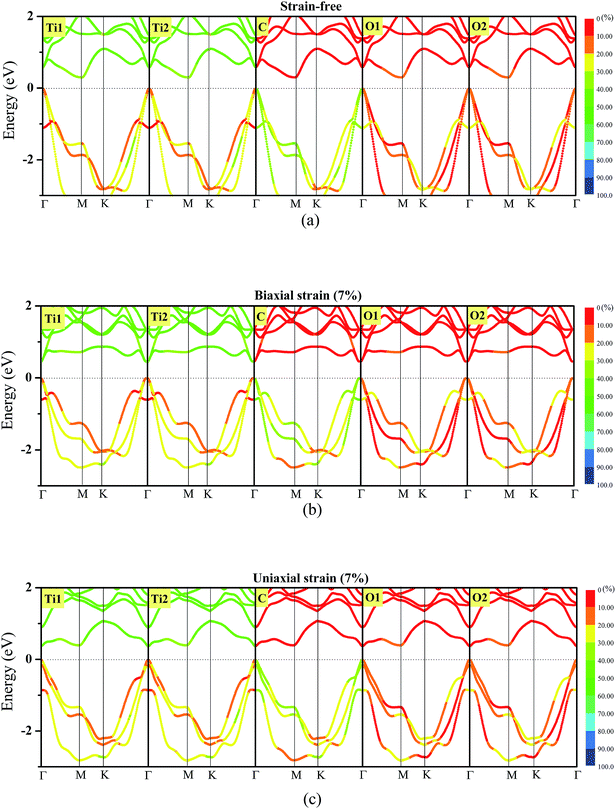 | ||
| Fig. 4 The contribution of each atom in monolayer Ti2CO2 to the energy level at (a) strain-free, (b) 7% biaxial strained and (c) 7% uniaxial strained states. | ||
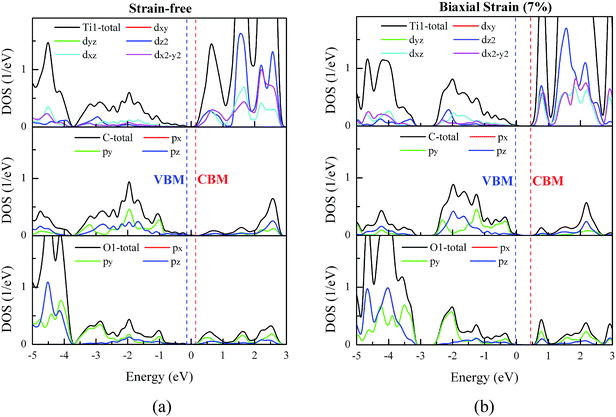 | ||
| Fig. 5 The partial density of state of monolayer Ti2CO2 at (a) strain-free and (b) 7% biaxial strain states. | ||
As we know, the band gap modulation is always accompanied by the charge transfer in the system. In view of this point, we have examined the bader charge distribution in the monolayer Ti2CO2 dependent on the biaxial strains. In the strain-free case, the bader charge distribution on Ti, C and O atoms are 1.92e, −1.65e and −1.09e, respectively. After 7% biaxial strain is applied, the Ti–C bond length (Fig. 1a) increases by 0.09 Å, resulting in the additional charge transfer from C to Ti atom by 0.02e. However, O atom obtains additional 0.04e, even though the Ti–O bond length increases by 0.07 Å. It could be understood that the distance between O atom and its second neighboring Ti atom decreases by 0.14 Å after 7% biaxial strain is applied, and thus the charge transfer from the Ti to O atom may occur. In Fig. 6, we plot the bader charge distribution of O atom, and the position of M point at the bottom of conduction band dependent on the biaxial strains applied on monolayer Ti2CO2, we found that the increased oxidation number of O atoms under biaxial strain cases strongly relate to the raising of M point at the energy level.
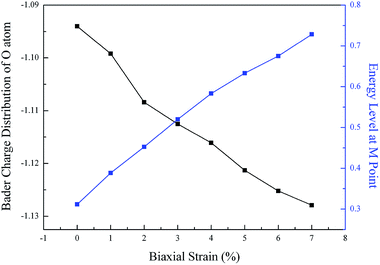 | ||
| Fig. 6 The bader charge distribution of O atom and the energy level at M point of conduction band dependent on the biaxial strains on monolayer Ti2CO2. | ||
It should be noted that, recent experiments on Ti3C2Tx (T represents OH, O or/and F) thin films showed that the strain to failure was only 1%.18 Using this value as a reference, the indirect–direct band gap transition in monolayer Ti2CO2 seems not happen under the predicted threshold strains (biaxial strain of ∼4%, and the uniaxial strain of ∼6%). It is noted that, in this study, we simplify the model of Ti2CTx with only considering the O termination. However, in experiment, Ti2CTx might be terminated with several groups (including OH, O or/and F) simultaneously, and thus the strain to failure might be different in each case. To examine the stability of the monolayer Ti2CO2 under the predicted threshold strains, the molecular dynamics simulations have been performed under both 300 K and 500 K, with the time step 2 fs, and total time 10 ps. The results reveal that the structure of monolayer Ti2CO2 is very stable under the predicted threshold strains. In addition, the frequency calculation on monolayer Ti2CO2 under the predicted threshold strains shows no imaginary frequency, which further confirms the stability of the system.
As has been mentioned in previous study,9 four types of O-terminated monolayer MXene belong to the semiconductor with indirect band gap: Ti2CO2, Zr2CO2, Hf2CO2 and Sc2CO2. Among these four structures, the band structure of monolayer Ti2CO2, Zr2CO2 and Hf2CO2 are quite similar with each other, since the Ti, Zr and Hf atoms belong to the same group. Thus, the band gap modulation (from indirect to direct) may also occur in monolayer Zr2CO2 and Hf2CO2 under the tensile strains. To confirm this point, we have examined the band gap modulation in monolayer Zr2CO2 and Hf2CO2 under the biaxial strains, the results reveal that indirect to direct band gap modulation occurs when 10% and 14% biaxial strains are applied on the monolayer Zr2CO2 and Hf2CO2 as shown in Fig. 7.
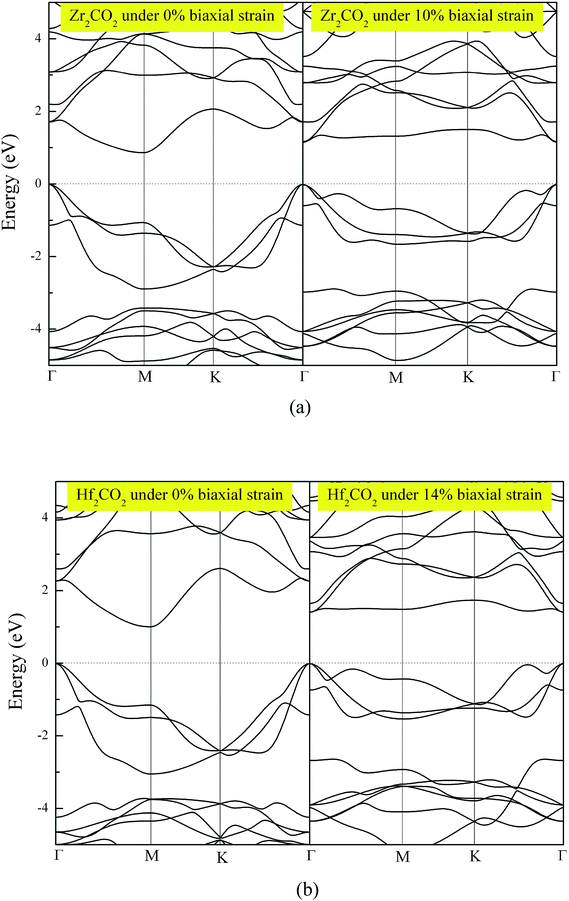 | ||
| Fig. 7 The band structures of monolayer (a) Zr2CO2 and (b) Hf2CO2 under 10% and 14% biaxial strain, respectively. | ||
4. Conclusion
In this work, the band gap modulation of monolayer Ti2CO2 under biaxial or uniaxial strain was studied through first-principles simulation. Our results reveal that an indirect to direct band gap transition could be realized when ∼4% biaxial or ∼6% uniaxial strain was applied on monolayer Ti2CO2. The origin of such band gap modulation is found to be the change of energy level at CBM state under strains, in which Ti and O atoms contribute to the CBM state in indirect case, while only Ti atom influences the CBM state in direct case. Furthermore, our results show that the band gap modulation (from indirect to direct) could also occur in the monolayer Zr2CO2 and Hf2CO2 when 10% and 14% biaxial strains are applied. The present study provides a route to realize the band gap modulation in two-dimensional MXenes for optical applications.References
- M. W. Barsoum, Mn+1AXn Phases: A New Class of Solids: Thermodynamically Stable Nanolaminates, Prog. Solid State Chem., 2000, 28, 201–281 CrossRef CAS.
- M. Naguib, V. N. Mochalin, M. W. Barsoum and Y. Gogotsi, 25th Anniversary Article: MXenes: A New Family of Two-Dimensional Materials, Adv. Mater., 2014, 26, 992–1005 CrossRef CAS PubMed.
- M. R. Lukatskaya, O. Mashtalir, C. E. Ren, Y. Dall'Agnese, P. Rozier, P. L. Taberna, M. Naguib, P. Simon, M. W. Barsoum and Y. Gogotsi, Cation Intercalation and High Volumetric Capacitance of Two-dimensional Titanium Carbide, Science, 2013, 341, 1502–1505 CrossRef CAS PubMed.
- Q. Tang, Z. Zhou and P. Shen, Are MXenes Promising Anode Materials for Li Ion Batteries? Computational Studies on Electronic Properties and Li Storage Capability of Ti3C2 and Ti3C2X2 (X = F, OH) Monolayer, J. Am. Chem. Soc., 2012, 134, 16909–16916 CrossRef CAS PubMed.
- Y. Xie, M. Naguib, V. N. Mochalin, M. W. Barsoum, Y. Gogotsi, X. Yu, K.-W. Nam, X.-Q. Yang, A. I. Kolesnikov and P. R. Kent, Role of Surface Structure on Li-Ion Energy Storage Capacity of Two Dimensional Transition Metal Carbides, J. Am. Chem. Soc., 2014, 136, 6385–6394 CrossRef CAS PubMed.
- X. Peng, L. Peng, C. Wu and Y. Xie, Two Dimensional Nanomaterials for Flexible Supercapacitors, Chem. Soc. Rev., 2014, 43, 3303–3323 RSC.
- Y. B. Lee, S. B. Cho and Y. C. Chung, Tunable Indirect to Direct Band Gap Transition of Monolayer Sc2CO2 by the Strain Effect, ACS Appl. Mater. Interfaces, 2014, 6, 14724–14728 CAS.
- L. Y. Gan, Y. J. Zhao, D. Huang and U. Schwingenschlögl, First-principles Analysis of MoS2/Ti2C and MoS2/Ti2CY2 (Y = F and OH) All-2D Semiconductor/Metal Contacts, Phys. Rev. B: Condens. Matter Mater. Phys., 2013, 87, 245307 CrossRef.
- M. Khazaei, M. Arai, T. Sasaki, C.-Y. Chung, N. S. Venkataramanan, M. Estili, Y. Sakka and Y. Kawazoe, Novel Electronic and Magnetic Properties of Two-Dimensional Transition Metal Carbides and Nitrides, Adv. Funct. Mater., 2013, 23, 2185–2192 CrossRef CAS.
- Y. Xie and P. R. C. Kent, Hybrid Density Functional Study of Structural and Electronic Properties of Functionalized Tin+1Xn (X = C, N) Monolayers, Phys. Rev. B: Condens. Matter Mater. Phys., 2013, 87, 235441 CrossRef.
- S. B. Desai, G. Seol, S. J. Kang, H. Fang, C. Battaglia, R. Kapadia, J. W. Ager, J. Guo and A. Javey, Strain-Induced Indirect to Direct Bandgap Transition in Multilayer WSe2, Nano Lett., 2014, 14, 4592–4597 CrossRef CAS PubMed.
- Y. Li, J. Kang and J. B. Li, Indirect to Direct Band Gap Transition of the ZrS2 Monolayer by Strain: First-principles Calculations, RSC Adv., 2014, 4, 7396–7401 RSC.
- G. Kresse and J. Furthmüller, Efficiency of ab initio Total Energy Calculations for Metals and Semiconductors Using a Plane-Wave Basis Set, Comput. Mater. Sci., 1996, 6, 15–50 CrossRef CAS.
- G. Kresse and J. Furthmüller, Efficient Iterative Schemes for ab initio Total-Energy Calculations Using a Plane-Wave Basis Set, Phys. Rev. B: Condens. Matter Mater. Phys., 1996, 54, 11169–11186 CrossRef CAS.
- G. Kresse and J. Joubert, From Ultrasoft Pseudopotentials to the Projector Augmented-Wave Method, Phys. Rev. B: Condens. Matter Mater. Phys., 1999, 59, 1758–1775 CrossRef CAS.
- Y. Wang and J. P. Perdew, Correlation Hole of the Spin-Polarized Electron Gas, with Exact Small-Wave-Vector and High-Density Scaling, Phys. Rev. B: Condens. Matter Mater. Phys., 1991, 44, 13298–13307 CrossRef.
- Y. Lee, Y. Hwang, S. B. Cho and Y. C. Chung, Achieving A Direct Band Gap in Oxygen Functionalized-Monolayer Scandium Carbide by Applying An Electric Field, Phys. Chem. Chem. Phys., 2014, 16, 26273 RSC.
- Z. Ling, C. E. Ren, M. Q. Zhao, J. Yang, J. M. Giammarco, J. S. Qiu, M. W. Barsoum and Y. Gogotsi, Flexible and Conductive MXene Films and Nanocomposites with High Capacitance, Proc. Natl. Acad. Sci. U. S. A., 2014, 111, 16676–16681 CrossRef CAS PubMed.
| This journal is © The Royal Society of Chemistry 2015 |

